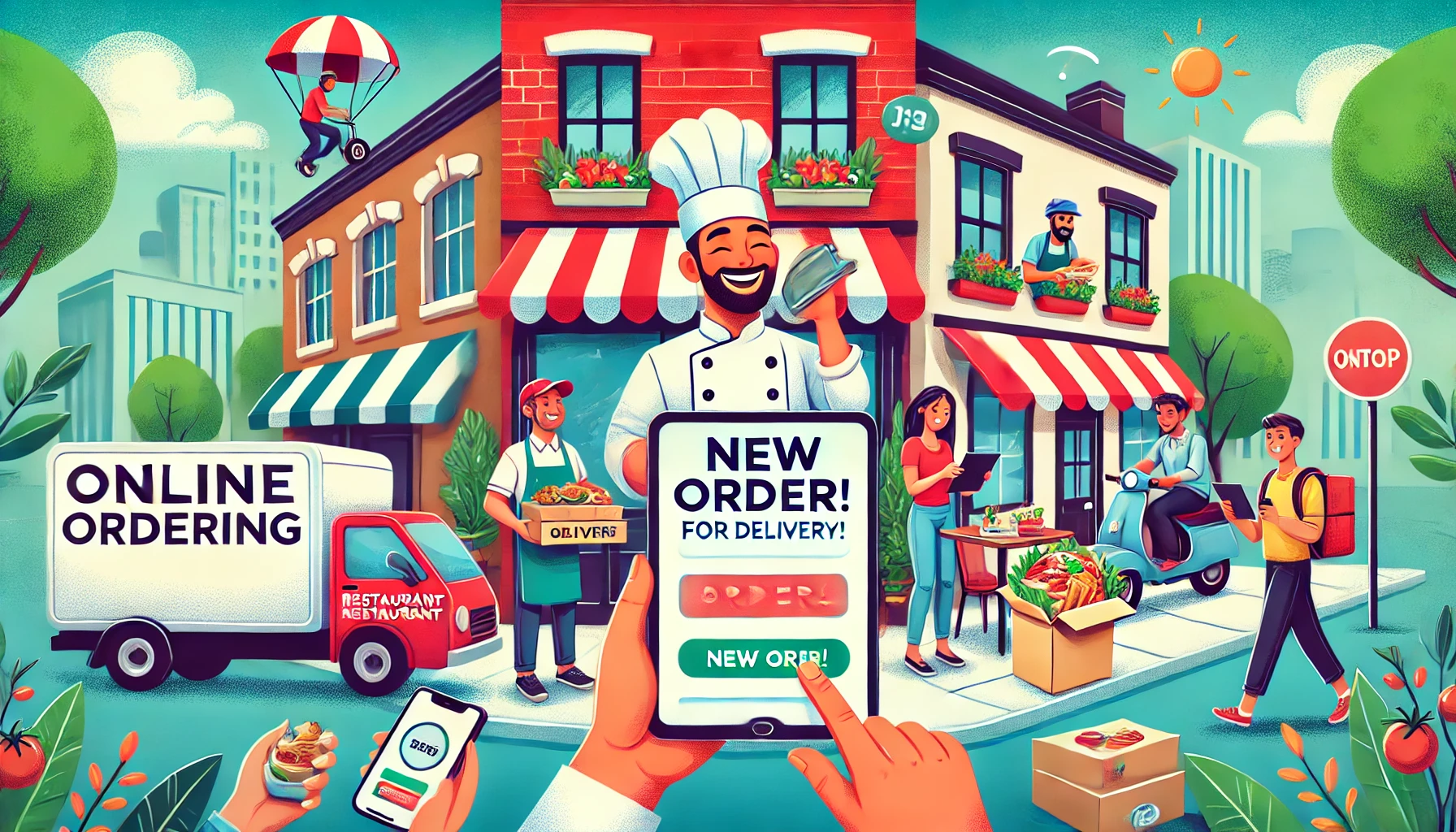The restaurant industry has undergone a seismic shift in recent years, driven by changing consumer habits, advancements in technology, and the increasing demand for convenience. Independent restaurants, in particular, must adapt to these changes to stay competitive in a landscape where large chains and third-party platforms dominate. One of the most effective ways to achieve this is by implementing an online ordering system.
In this article, we will explore why independent restaurants need an online ordering system, how it can improve profitability and customer experience, and why relying on third-party platforms is not a sustainable long-term strategy.
The Changing Face of the Restaurant Industry
Consumer Behaviour is Shifting Towards Online Ordering
The rise of digital convenience has led to a fundamental shift in how consumers interact with restaurants. Today’s customers expect to be able to browse menus, place orders, and make payments online with minimal effort. Mobile technology and food delivery apps have normalised this expectation, making an online ordering system essential for independent restaurants that want to meet customer demands.
The Rise of Third-Party Delivery Platforms
While platforms like Deliveroo, Uber Eats, and Just Eat offer visibility and convenience, they also come with significant drawbacks. The commission fees charged by these platforms—often as high as 30%—eat into already tight profit margins. Moreover, restaurants have little control over customer experience, branding, and data. An independent online ordering system allows restaurants to bypass these high fees while retaining full control over their business operations.
The Benefits of an Online Ordering System for Independent Restaurants
1. Increased Revenue and Profitability
Online ordering systems provide a direct revenue stream without the burden of commission fees associated with third-party delivery apps. By processing orders through their own platform, independent restaurants can retain more of their profits and set their own pricing structures.
Additionally, online ordering encourages larger order values. Customers tend to spend more when ordering online compared to in-person orders, as they are not rushed and can browse the full menu at their leisure. Upselling and cross-selling opportunities, such as meal deals or add-ons, can also be integrated into an online ordering system to further increase revenue.
2. Enhanced Customer Experience and Loyalty
An independent online ordering system allows restaurants to provide a seamless and branded customer experience. Unlike third-party apps that standardise restaurant listings, a dedicated system enables restaurants to tailor the user interface, highlight special offers, and maintain direct communication with customers.
Additionally, having a loyalty programme or offering exclusive discounts through an online ordering system encourages repeat business. Unlike third-party platforms, where customers may be lured away by competing restaurants, a restaurant-owned system fosters direct relationships and customer retention.
3. Improved Operational Efficiency
With an online ordering system, orders are placed digitally and sent directly to the kitchen, reducing errors associated with phone orders or miscommunication. Automated order tracking, payment processing, and customer notifications streamline operations, allowing restaurant staff to focus on preparing food rather than handling orders manually.
Restaurants can also control order flow to prevent overwhelming kitchen staff during peak times, ensuring a smoother and more efficient operation.
4. Better Control Over Brand and Customer Data
Owning an online ordering system gives restaurants full control over their branding, menu presentation, and customer interactions. This means independent restaurants can create a personalised experience rather than being just another listing on a third-party platform.
Furthermore, customer data is invaluable for marketing and business growth. With a third-party platform, restaurants have limited access to this data. However, with an independent system, they can collect customer information, track order patterns, and send targeted promotions via email or SMS marketing.
5. Lower Marketing Costs and Increased Visibility
Many independent restaurants rely on word-of-mouth or social media marketing. While these are effective, they can be unpredictable. An online ordering system provides a centralised platform where restaurants can showcase their menu, promotions, and business information without relying on external platforms.
By integrating search engine optimisation (SEO) strategies, restaurants can increase their visibility on Google and attract more local customers searching for online food ordering options. A well-optimised website with an integrated ordering system can significantly reduce reliance on paid advertisements and third-party marketing.
6. Flexibility in Pricing, Promotions, and Delivery Options
Restaurants using third-party apps have little control over pricing structures due to commission fees. With an independent online ordering system, they can adjust menu prices without external interference, set up special promotions, and offer exclusive discounts to loyal customers.
Additionally, restaurants can choose whether to offer delivery, click-and-collect, or dine-in pre-orders. This level of flexibility ensures that they can cater to different customer needs without being restricted by the rules of external platforms.
Addressing Common Concerns About Implementing an Online Ordering System
1. “It’s Too Expensive to Set Up”
Many independent restaurant owners assume that developing an online ordering system requires significant upfront investment. However, numerous cost-effective solutions are available, ranging from ready-made platforms like OrderFor.co.uk to fully custom-built systems.
In the long run, the savings from avoiding third-party commission fees and increased order volumes will outweigh the initial setup costs.
2. “I’m Not Tech-Savvy”
Modern online ordering systems are designed with user-friendliness in mind. Many providers offer intuitive dashboards, step-by-step guidance, and ongoing customer support. Even restaurant owners with minimal technical knowledge can quickly learn to manage their platform.
3. “My Customers Prefer Calling to Place Orders”
While some customers still prefer calling, an increasing number prefer the convenience of online ordering. Offering both options ensures that all customer preferences are accommodated while reducing the workload on staff answering calls during busy periods.
How to Successfully Implement an Online Ordering System
1. Choose the Right Platform
Selecting the right online ordering system is crucial. Key features to look for include:
- Customisable branding
- Mobile-friendly design
- Secure online payments
- Order tracking and notifications
- Integration with existing POS systems
2. Optimise Your Menu for Online Orders
Menus should be clear, well-organised, and visually appealing. High-quality images, detailed descriptions, and allergen information help customers make informed choices and encourage higher order values.
3. Promote Your Online Ordering System
Simply having an online ordering system is not enough; restaurants must actively promote it. Strategies include:
- Adding a prominent ordering button on the website
- Promoting it on social media
- Offering first-time order discounts
- Encouraging customers to order directly rather than through third-party apps
4. Ensure Seamless Order Fulfilment
Efficiency is key to maintaining a positive customer experience. Restaurants should train staff on handling online orders, set realistic delivery times, and maintain clear communication with customers regarding order status.
Conclusion
The restaurant industry is more competitive than ever, and independent restaurants must embrace technology to stay ahead. Implementing an online ordering system is not just a trend—it is a necessity for growth, profitability, and long-term sustainability.
By reducing reliance on third-party platforms, increasing revenue, improving customer experience, and streamlining operations, an online ordering system is one of the most powerful tools an independent restaurant can invest in.
Now is the time for independent restaurants to take control of their online presence, build direct customer relationships, and future-proof their business with a dedicated online ordering system.


